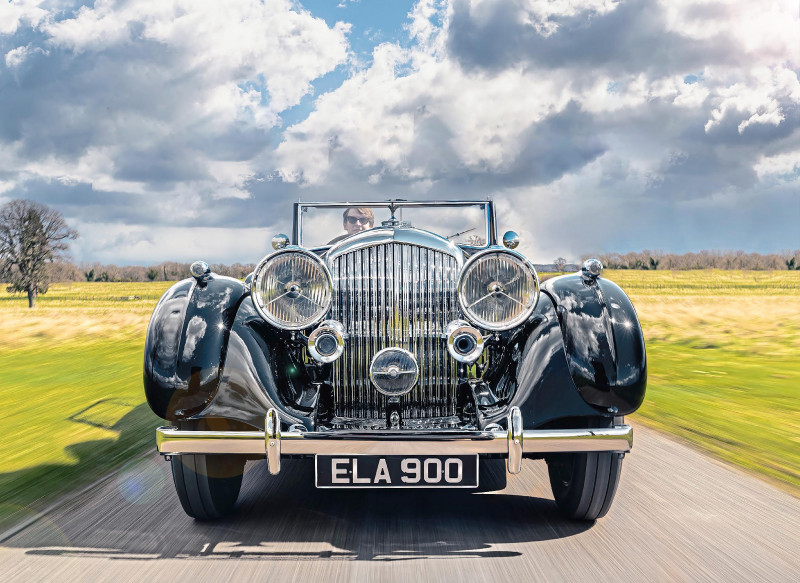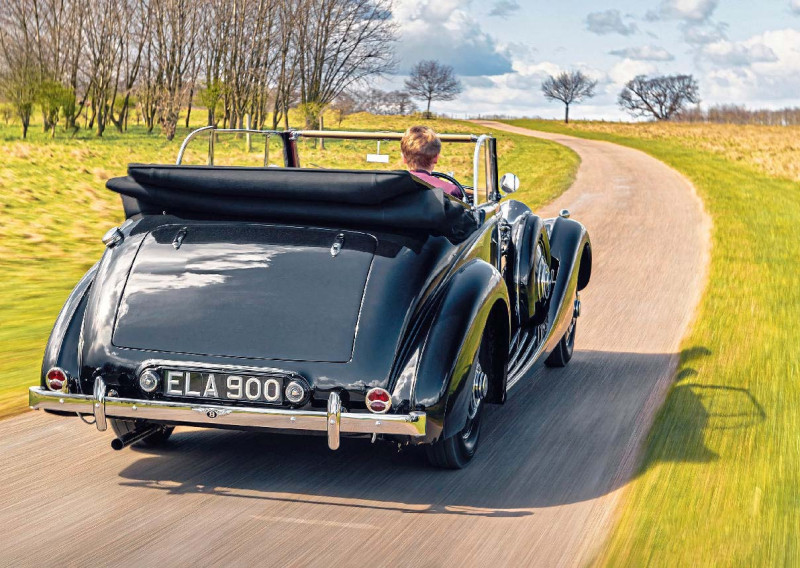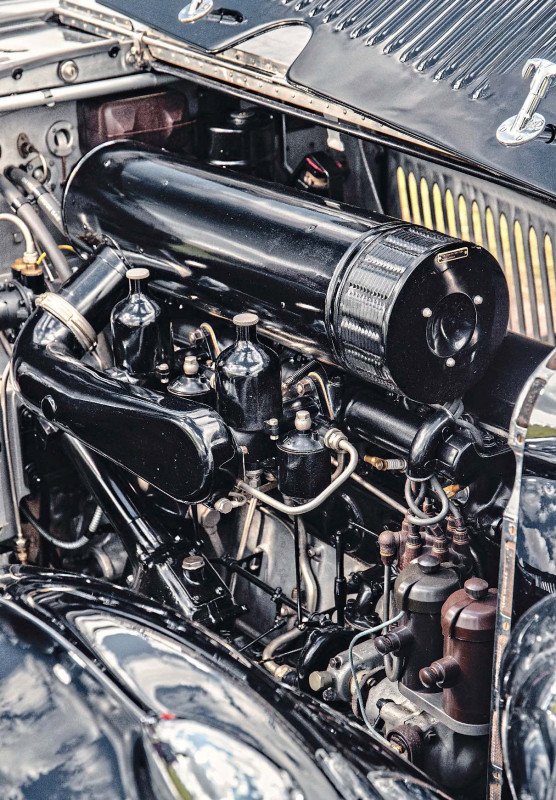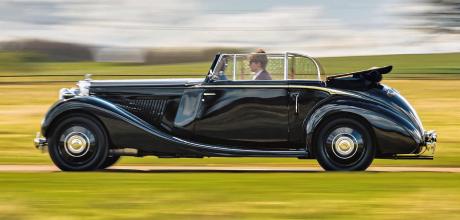1937 Bentley 4¼ litre James Young DHC
Opportunity knocked when a coachbuilder invented cantilevered sliding doors.We drive one of seven Bentley 4. Parallel-Door DHCs to test the novel system.
Photos: JONNY FLEETWOOD
Words: EMMA WOODCOCK
Slide into the world of a Bentley with an art-deco design secret
Parallel Universe Stepping into the glam world of a cantilever-door Bentley drophead
Rare weird-door Bentley driven

The 1937 Bentley 4. Litre Parallel-Door Drophead Coup. by James Young motors up to the entrance of a country house hotel. Its swooping pontoon wings stretch as long as its full name, framing an upright body that meets modern Range Rovers and Porsche Cayennes at eye level. Perched high on plump claret leather, bringing the behemoth to a halt with a twitch of the light, eager brakes and a final haul of the stiffening steering wheel, I have arrived. All that remains is to disembark – and that’s where this coachbuilt creation dazzles. As the patented door assembly slides out then back in tightly choreographed sweeps, Art Deco gracefully meets the cutting edge of mid-Thirties industrial design.

Getting out could scarcely be easier. Eschewing conventional hinges in favour of a cantilevered system that moves the entire panel away from its aperture, the Parallel-Door creates the unimpeded space for its occupants to simply step down out of the cabin. There’s no shimmying past metal and leather. Once I’ve completed the ‘Derby’ Bentley ritual of scooting both feet past the right-mounted gearlever and fly-off handbrake, I simply pivot round by 90 degrees, stand up and step out. It’s no trickier than descending a short flight of stairs.

Though hidden from view, the parts executing the parallel-action concept impress with the same simplicity. Twin triangulated frames form the heart of the structure, connecting with pivots in the centre of the door panel to allow a controlled arc of movement around body-mounted brackets that are positioned alongside. By mounting the hinges at a subtle angle, James Young craftsmen also ensured that the system can close under its own weight, while a recess within the door provides a space to tuck away the mechanicals as the latch clicks shut. It all functions flawlessly when I clamber back aboard. A click of the chromed handle and the door glides softly outwards with the slightest effort, tracking a convex arc that traces the structure backwards, only demanding a weightier shove as it reaches the final inches of its action. The opened door stands eight inches proud of the body, its upholstery linked to the rest of the interior by a folding leather panel that moves with the structure to conceal its working parts. With a light but certain tug, the Parallel-Door closes and I can turn my attentions to the drive.

Starting the Bentley 4. Litre is the work of a second. Flick down the central ignition tab, thumb the starter button to the immediate left of the steering wheel and the 4257cc inline-six settles straight to its 700rpm idle. Getting underway is no more challenging. I tug and tap the tapered gearknob through a controlled movement with heavy, decisive springing, finding first in the conventional H-pattern four-speed, then lift the leftmost organ pedal to welcome a gradual and viceless clutch bite. The Bentley rolls smoothly forwards, accelerating to a brisk walking pace without a whisper of accelerator input.

As the Smiths speedo tickles towards double figures, the Bentley finds it feet. The steering, almost immovable at a standstill, sheds its shoulder-straining low-speed manner to reveal a light, precise system that rarely demands more than a quarter turn of lock, only gaining weight through the tightest junctions. Pushing the servoed brakes reveals the same civility, the light yet firm pedal reacting to length not strength of application. I push through initial sponginess to find responses from the all-round 300mm drums are dependably strong. Yet these are only the supporting acts. As I click up through the tightly-controlled gearbox, complete with third and fourth gear synchromesh, the Drophead Coup. defines its driving experience with imperious roadholding and an engine that, so long as I stay within its preferred operating parameters, provides limitless torque and refinement. Pass 1200rpm and the huge straight six emerges as a quiet, smooth and flexible device that responds instantaneously to each nudge of the slim, conventionally positioned accelerator.
Underpinned by a slight, cresting exhaust hum and subtle transmission whine but few other mechanical sounds, this oasis of calm and unstressed urge spans well past the 1750rpm torque peak, only ebbing when a high-pitched intake whistle enters proceedings above 2600rpm. I try venturing further and discover an engine that turns ever breathier and more vocal, so I drop back and cruise where the car prefers. That’s no hardship.
Slotting third gear, I can enjoy the very best of what Bentley fittingly named its ‘Silent Sports Car’ at any speed from 15 to 40mph. Push further and the Bentley is a monumental machine, its exhaust rising to a flat, guttural thunder when I venture towards 3000rpm. The mass of the car is ever more apparent, the front suspension oscillating like ocean swells over larger bumps, each steering input revealing a lull then pronounced roll. On the fastest roads I quickly fall behind the car, so I cool my pace and feel its laconic yet domineering personality return.
Confident that the engine can unobtrusively meet my every demand, I’m free to enjoy the commanding but quietly enthusiastic way the 4. Litre surges over the road. Sat far back from the farthest reaches of the bisected bonnet, there’s a noticeable gap between my steering input and any movement at the front wheels but, once the light, direct worm-and-nut completes its action, cornering is instant and assured. Thank the incorporation of a 3200mm wheelbase within a 4200mm total length: the equivalent of somehow cramming a modern BMW 7 Series LWB under the same company’s 1 Series hatchback, and enough to pair agility with sweeping security.
With a 1617kg kerbweight to provide momentum and roll into the semi-elliptic leaf springs, it feels like nothing could throw us off course. The body leans slightly as the car takes up its angle, then the steering sets stiffly in position and the car pulls itself through the turn. Minor surface imperfections are treated with the same shrugging disregard, disappearing beneath the Bentley’s hydraulic dampers and mighty mass without ever murmuring through the seat. Cattle grids and larger lumps puncture the resolve, but only enough to summon a single bounce-jounce before the car settles.
Little can bother me as I lope along, sitting high off the ground yet cocooned within the high-sided cabin. My legs sprawl straight ahead and warm air cascades over the windscreen, gently tussling my hair. Sinking deeper into the sunbeamstitched red leather, it strikes me that cars come no better for touring an ever-busier metropolis. It’s no surprise, then, that ELA 900 started life in London, where the elegant accessibility of its James Young door arrangement only bolstered its appeal. Striking yet sensible, the Parallel-Door enjoyed steady sales from its introduction until the outbreak of World War Two. Debuted at the 1935 Olympia Motor Show – where James Young exhibited its second chassis thus equipped, a 3. Litre Bentley – the door system was profiled in The Motor and soon entered production. Its London coachbuilder would go on to mount the innovation to a total of 15 chassis, of which three were 3. Litre ‘Derby’ Bentleys and seven later 4. Litre machines. Rolls- Royces account for the remainder, James Young converting a single 25/30, a pair of 20/25s and two Phantom III limousines.
Such luxurious conveyances were a far cry from the sombre event that inspired them. Inventor George Harold Wenham first sketched the concept in response to a Parisian traffic accident he’d witnessed moments before, where a woman had been knocked to the ground by the errant opening of a passing car’s rear-hinged ‘suicide’ door. On a scrap of paper, he swiftly drew out the fundamentals of a sliding door mounted on a pair of cantilevers, which could never threaten the same danger. As works director of James Young Ltd, Wenham was wellplaced to bring his concept to fruition. With the assistance of car dealer Archibald H Pass – co-proprietor of regular James Young client Pass & Joyce Ltd – the draught was developed into a July 1935 patent application. It would be granted the following year, when Wenham also successfully applied for further patent protection in France, Germany and Canada.
With the invention recognised, his employer began allowing other coachbuilders to use the Parallel-Door system under licence. British firm Bertelli fitted the system to a sole Alvis Speed 25 in late 1936 and German builder Autenrieth employed it on a pair of BMWs, but the most striking application was by Saoutchik. In 1938 the French stylists incorporated Wenham’s doors within the Hispano-Suiza H6B Dubonnet Xenia prototype. ELA 900 motored into the capital a year earlier, when first owner Captain SCE Lloyd registered his new car to Shell Mex House, WC2 on 20 October 1937. Supplying dealer Pass & Joyce had commissioned the car six months earlier, Bentley delivering bare chassis B172KT to James Young in June. The Drophead Coupé body the firm crafted added 9cwt (457kg) to the unladen chassis weight, with a design crafted for ‘town and touring’.
The Captain wouldn’t keep the car long, though. On 31 January 1939 the Bentley sold through marque specialist Jack Barclay to Norwood Park resident HF Shepherd, who paid í525.0.0 and a part-exchanged Bentley 3ó Litre saloon. The next year, the car was sold to Sir Arthur Cory-Wright, 2nd Baronet and famed dramatist Simon Harcourt Smith in quick succession, before landing with Sir Rupert WJ Clarke in 1941. The Sydney-born Baronet kept his Parellel-Door Bentley close to London while serving in the British Army as aide-de-camp of Lieutenant-General Sir Harold Alexander, storing the car in the UK when he returned to Australia after the war.
After a slew of keepers in Grosvenor Square, Westminster and Essex, B172KT mounted its own international expedition and – following a decade-long documentary black spot – appeared in Pittsburgh, Pennsylvania around 1971. Repatriated 18 years later, the derelict but complete Bentley sold to Denis Clark in 1989. The Buckinghamshire enthusiast immediately embarked on a í250,000 restoration, engaging Clanfield Coachbuilding to reconstruct the bodywork and Fiennes Classics to pellet and rebuild the engine, gearbox and rear axle. Sadly, Clark didn’t live to see the car completed. Following his death in 2011, the partcomplete project was set to be sold by Sotheby’s.
It never made it across the auction block. Incorrectly billed as a non-original Drophead Coupé and offered as a jumble of parts stored in various workshops, the car caught the eye of current owner Clynt Wellington for the quality of its renovation work. Trusting his gut, he bought B172KT for í60,000 and hunted down every book on ‘Derby’ Bentleys, hoping one would prove his car’s originality. One did, spurring him to contact Rolls- Royce Enthusiasts’ Club model registrar Richard Edgell, who located the original build sheets and confirmed its identity. Glistering in 22 coats of cellulose black and new, as-original red leather, ELA 900 is a sumptuous ode to a system that barely outlasted the 85 year-old Bentley’s construction. Subsumed by Jack Barclay Ltd in 1937 and fire-bombed during the Blitz – destroying all factory records – James Young would never build another Parallel-Door car when hostilities ceased, Wenham having perished in a 1940 landmine explosion.
And yet, despite its rarity and rakish foundations, the concept flourished. VW bought the patent from James Young before debuting its own sliding door on the 1963 Kombi van; later systems for Daimlers, Toyota minivans and the Peugeot 1007 all acknowledge the Wenham precedent. School-run mums and delivery-van drivers will never know, but their everyday practicality takes a trail blazed by an extraordinary Bentley.
‘It was incorrectly billed as a non-original DHC and offered as a jumble of parts
Radiator cowl was uncovered in previous owner’s loft Boss-mounted switch tailors rear damping control Rediscovered brightwork was forwarded to Clynt after sale Assured Bentley sweeps minor roads into submission.
TECHNICAL DATA 1937 Bentley 4¼ litre James Young DHC
- Engine 4257cc inline six-cylinder, pushrod ohv, twin SU HV5 carburettors
- Max Power 125bhp @ 3800rpm
- Max Torque 167lb ft @ 1750rpm
- Transmission Four speed manual with synchromesh on third and fourth, rear-wheel drive
- Steering Worm and nut
- Suspension Front: solid axle, semi-elliptic leaf springs, Rolls-Royce hydraulic dampers. Rear: live axle, semi-elliptic leaf spring, Rolls-Royce hydraulic dampers with adjustable ride control
- Brakes Servo-assisted drums all round
- Performance 0-60mph: 14,9sec
- Top speed: 96mph
- Weight 1617kg (3565lb)
- Fuel consumption 12mpg
- Cost new £1160 (bare chassis before bodywork)
- Classic Cars Price Guide £110,000-£320,000
REGISTERING CHASSIS B172KT
Clynt Wellington fought hard to have his 4. Litre recognised under its original identity. ‘It took months of research with the help of the Rolls-Royce Enthusiasts’ Club and Bentley Drivers Club, which culminated in me contacting the still-extant Jack Barclay Bentley dealership. They uncovered the 1939 order form that proves my car is a Drophead Coup… It’s signed by Jack Barclay himself! BDC and RREC updated its records immediately, recognising B172KT as a James Young DHC. ‘I still had to get the car road-registered. The DVLA refused to re-allocate the original registration plate or issue a replacement logbook at first, advising that its records only showed my car as an imported vehicle. They wanted to put the car on a Q plate! I sent original import and export documents, plus evidence of its 1937 delivery, but they still wouldn’t budge. They’d only issue a logbook if I could provide the exact date of first registration. ‘With the previous American owner uncontactable, the BDC came to my rescue. The chairman of the club Eligibility Committee stated that the registration date must be 1 October 1937 because this was the date Bentley guaranteed the car, and no car was guaranteed until paid for and taxed. The DVLA relented and ELA 900 was reunited with her original registration number.’
‘Once the light, direct worm-and-nut steering completes its action, cornering is instant and assured
‘A click of the chromed handle and the door glides softly outwards with the slightest effort’
Flick tab, push button and the Bentley starts instantly Bentley L inline-six was developed from a Rolls design Art Deco seats restored to original appearance.


